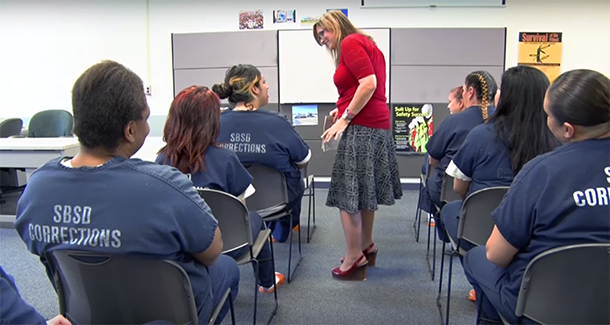
(Image from San Bernardino County Sheriff’s Department video)
From learning anger management to culinary skills, inmates in San Bernardino County’s detention centers have access to a variety of programs that will help them while in custody and prepare them for life after release.
The San Bernardino County Sheriff’s Department provides 24 classes, programs, and resource fairs for the inmates at its four facilities. Some of the classes — such as substance abuse and cognitive skills — are court-ordered. The voluntary classes teach specific job skills like basic construction, or life skills such as religious services and parenting. The department partners with community, educational, and religious organizations to provide some of the classes.
“Sometimes they just need somebody who’s going to give them hope and give them an opportunity and treat them like a human being who has the potential to change,” said Chris Martin, San Bernardino County Sheriff’s inmate programs coordinator, who oversees the services offered to all inmates except for the mentally ill and medically fragile.
The department created a video about the services it provides for inmates:
“So by helping them become better people, they’re able to be better family members and then that ripples out into the community because we’re not keeping these people for life,” added Martin. “Eventually they’re going to be going back out into the community. They’re going to be our neighbors. We’re going to see them at the grocery store. We’re going to run into them in public and they need to know how to behave back in society. We need to start teaching them that while they’re here.”
When the state legislature passed AB109 in 2011, the law placed more responsibility on the counties to incarcerate and rehabilitate inmates. As a result, classes and programs like these are increasingly necessary, explained Assistant Sheriff Shannon Dicus.
“Prison Realignment in California has left law enforcement very few tools to protect the public. Focusing on giving inmates the basic skills to become productive members of society is one of the few options left,” said Dicus. “The San Bernardino Sheriff's Department is committed to public safety by introducing rehabilitative programs that aim at successfully reintegrating offenders back into our communities.”
The classes are popular. Approximately 550 inmates participate in the court-ordered INROADS programs and about 3,700 inmates participate in the voluntary programs with many more on the waitlists.
Enrollment is based on a court order, release date, and classification level. If an inmate’s classification level prohibits participation in a classroom setting for safety and security reasons, they may be enrolled in a one-on-one or independent study situation.
Martin’s office also receives suggestions for new classes from the inmates and from community organizations. The program will grow and possibly include data on how the classes are contributing to successful reentry.
“We give them an opportunity to see things in a different way, to learn how to make better choices, to think things through,” concluded Martin.

